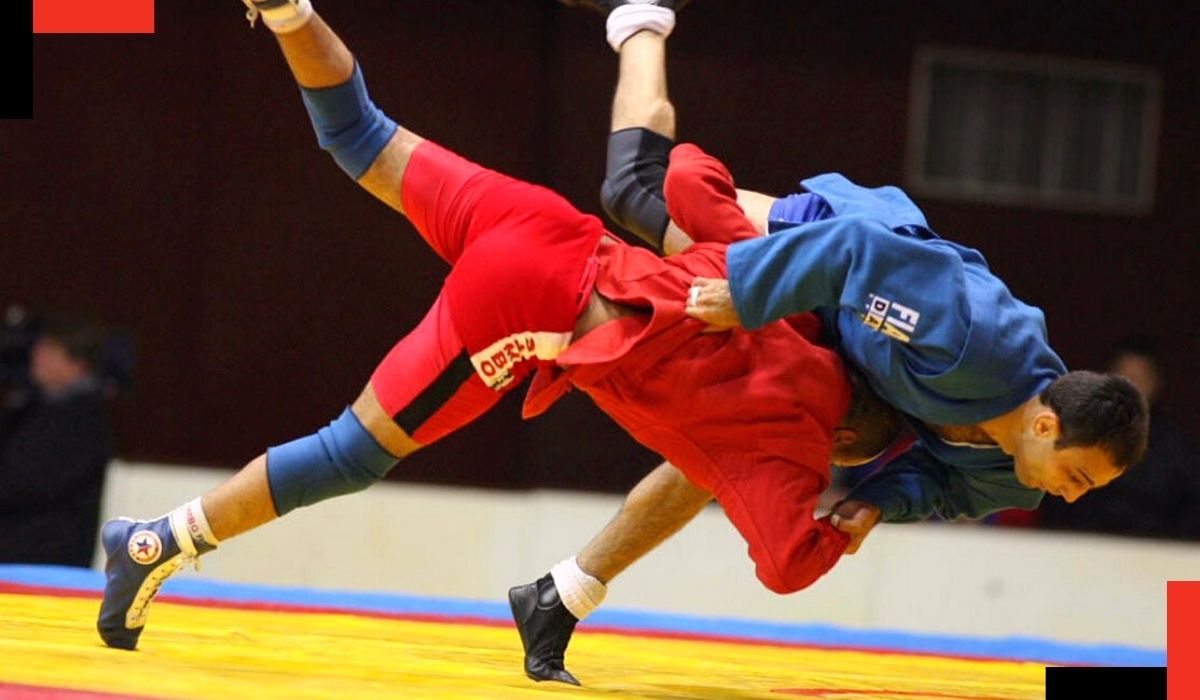Russian Sambo vs BJJ? Both of these martial arts offer fantastic opportunities for fitness and self-defense. However, the question is, which one should you choose?
Regarding grappling martial arts, Sambo and Brazilian Jiu-Jitsu are two of the best choices for MMA, self-defense, and overall fitness. But, it’s not a matter of which is better, but rather which aligns best with your personal goals, physical abilities, and preferences.
This article will investigate Sambo and BJJ’s unique advantages and potential drawbacks. By exploring these martial arts from different angles, you can decide which discipline, or perhaps a combination of both, is best suited to your aspirations.
What Is BJJ?

Brazilian Jiu-Jitsu (BJJ) focuses entirely on teaching ground grappling techniques to overcome opponents using the right combinations. For example, practitioners of this combat sport may utilize joint locks and chokeholds to gain a dominant advantage over their opponents to make them submit.
BJJ was developed around 1920 by Brazilian brothers Carlos, Oswaldo, Gastão Jr., George, and Hélio Gracie after Mitsuyo Maeda, a traveling Japanese judoka, trained Carlos in traditional Kodokan Judo.
Over the years, BJJ became a prominent martial art in the MMA world. Organizations such as the International Brazilian Jiu-Jitsu Federation (IBJJF) set the rules and standards for competitions, belt ranking system, athletes ranking, etc.
What Is Russian Sambo?

Sambo is a Russian grappling sport with various Judo, jujutsu, and different wrestling and self-defense techniques. It is a blunt, hard-hitting fighting style with two categories: combat sambo and sports sambo.
Combat sambo employs intense martial arts techniques (groin strikes, headbutts, chokeholds) and is used mainly by the Russian military. Emphasis is laid on knocking out the opponent as quickly as possible. However, sports sambo is a watered-down version of combat sambo, focused on catch-wrestling.
Russian Sambo was developed in the 1920s by the Soviet NKVD and Red Army to improve the hand-to-hand combat skills of conscripted soldiers.
The pioneers of Sambo — Viktor Spiridonov and Vasili Oshchepkov — were trained in different martial arts and wrestling styles. Therefore, they combined the best techniques they knew to form the most efficient self-defense discipline without using any weapons, named “Sambo.”
Sambo vs BJJ: What’s the Difference?
The critical difference between the Sambo and BJJ appears in the kind of techniques that you can use to submit an opponent.
You can apply several submission techniques in BJJ, such as joint locks, chokeholds, etc. However, sports sambo allows only arm and leg joint locks. Otherwise, Combat Sambo does permit chokeholds as well.
Besides this principal difference, there are still many other differences between Sambo and BJJ. Let’s have a detailed look at each of them.
- Expert Knowledge
Brazilian Jiu-Jitsu experts know more about grappling techniques on the ground and may learn takedowns. On the other hand, Sambists (Sambo fighters) know about grappling techniques both on the bottom and standing.
BJJ experts are proficient at almost all types of submissions, except for the forbidden ones like neck cranes. Sports Sambists are good at arm and leg locks, while combat Sambists are good at chokeholds.
Generally, BJJ and sports Sambists do not learn striking styles. Meanwhile, combat Sambists are trained in various strikes (punches, kicks, elbows, and knees).
- Points Scoring System
In BJJ, points are rewarded for the various maneuvers and positions. Meanwhile, in sports Sambo, points are given for hold-downs, throw performances, position, and much more. Combat Sambo also gives out points for strikes.
- Match Time
Sambo matches are usually five minutes long, while BJJ matches last five to ten minutes. This time can vary, depending on the competition’s rules, participants’ age, gender, belt level, capability, and strength.
- Match Rules
Brazilian jiu-jitsu tournaments have their own particular set of rules. At the same time, Sambo matches mostly follow the rules of Judo competitions with a few key differences. For example, points or submissions can win both, and just like in Judo, a Sambo match can be won by doing a perfect throw.
BJJ vs Sambo: Which is Better?
The answer to this is that neither is better than the other. Both are different yet deadly martial arts. Each style’s circumstances, advantages, and disadvantages dictate which is more appropriate for you.
Sambo or BJJ, Which Is Better for Beginner Martial Artists?
The thing is, not all beginner martial artists are kids. But, on the other hand, plenty of people take an interest in martial arts in their 20s or 30s. And so, keeping that in mind, the best for any beginner martial artist, young or old, is BJJ.
Brazilian Jiu-Jitsu is an incredible first martial art because of how well it teaches you self-defense. In addition, since it doesn’t include strikes, training is relatively more straightforward, and injuries are less.
BJJ is suitable for kids since it’s very safe: it doesn’t involve any intense wrestling slams or throws that can cause severe injuries. In addition, it consists of rolling around on mats a lot, which is perfect for those playful kids to burn off their excess energy.
Furthermore, Brazilian jiu-jitsu martial art is perfect for adults since it is a complex, intricate art requiring patience. You cannot rush through BJJ, so coaches find adults much more accessible to teach.
Sambo Vs BJJ: Which Is Better for MMA?
Sambo and Brazilian jiu-jitsu are suitable for MMA because they teach great fighting concepts that are applied in mixed martial arts matches.
BJJ is an appropriate foundation style for MMA since it can be built on by cross-training other martial arts. In addition, it’s a very versatile style. Although it lacks strikes, it can be learned in conjunction with some types heavier on the strikes.
On the other hand, combat Sambo covers all the bases: standing and on-ground grappling techniques, takedowns, and strikes. It’s the entire package, so adapting combat Sambo to the cage is much easier.
Ultimately, BJJ is the better choice if you’re willing to incorporate other styles in your training regime. If not, then go with combat, Sambo.
Recommended: This article looks at the best jiu-jitsu gis for beginners. It will help you select the most appealing Gi for your training, whether you’re just starting or have some expertise.
Sambo Vs Brazilian Jiu-Jitsu: Which is Better for Weight Loss?
Sambo and Brazilian Jiu-Jitsu are high-intensity sports that burn many calories in each training session.
That being said, Sambo is the better choice for weight loss since it involves stand-up grappling, which is more demanding in cardio. In addition, since combat Sambo consists of striking, it helps burn more calories than BJJ.
Related: Muay Thai, Brazilian Jiu-Jitsu, Krav Maga, Kickboxing, Taekwondo, and Karate are practical martial arts for weight loss and fat burning. Click here to learn more!
Sambo or BJJ, Which Is Better for Building Muscle?
Sambo is yet again the better option if you want to build muscle. It is a fantastic fitness exercise based on cardiovascular endurance training and hence helps build muscles more.
Yeah, BJJ also helps build muscle, but only to an extent. It primarily focuses on knocking your opponent to the ground quickly and efficiently, so you must conserve your energy. So, BJJ won’t help build muscles but will make you lean.
Related: Apart from being a highly social grappling sport, jiu-jitsu is a terrific workout to improve your fitness and reduce weight. Click here to learn more!
Should I Learn Sambo or BJJ for Self-Defense?
Sambo and BJJ are suitable for self-defense since both utilize grappling techniques, which can be used to bring down, restrain, and incapacitate any attacker.
BJJ allows a much smaller person to knock out a larger opponent to the ground quickly. And once you have that done, you can easily make them submit. Indeed, it is very effective in street fights since the battle ends on the ground more often.
On the other hand, Sambo significantly combats Sambo, is fast-paced and hits hard. Moreover, the striking techniques learned can be used to disarm any assailant. And since this style was developed for Soviet soldiers, needless to say, it is more than enough to knock out multiple threats.
Even though BJJ has excellent street-fight skills, Sambo is ultimately the better choice. This is because attackers are usually armed with melee weapons, which Sambo will help deal with.
Related: Martial arts may be an excellent tool for self-defense in any scenario. Click here to discover the most efficient martial arts techniques and training methods for keeping yourself safe and secure.
Final Thoughts
Brazilian jiu-jitsu and Sambo are two of the best martial arts to learn. As a result, they are gaining many fans and followers. They are valuable training activities that many people engage in because of their numerous benefits. First, however, you should start with BJJ grappling.
This post taught us a lot about Sambo and BJJ to help you decide which discipline to train. Here’s a quick rundown of what we’ve discovered thus far:
- Brazilian jiu-jitsu is a grappling fighting discipline that teaches pupils to overcome opponents through precise techniques. It does not, however, teach hitting skills.
- Sambo is a Russian grappling sport that combines Judo, Jujutsu, and other wrestling and self-defense methods. It is a direct, hard-hitting fighting style divided into combat sambo and sports sambo.
- Sambo and BJJ may help you reach your peak fitness objectives by improving your strength, muscle tone, etc.
- Sambo and Brazilian jiu-jitsu are excellent for MMA and self-defense because they both teach fantastic combat sports that can be used to defend oneself.
- BJJ and Sambo training burns more calories because of the high-intensity exercise, which is fantastic for weight loss.
I hope you found this post informative as you learn more about Sambo and Brazilian jiu-jitsu. Consequently, you can choose the proper grappling discipline that will suit your needs and objectives.
This report stimulated your attention! Please share it with a friend or post it on social media. Thank you very much!
Related: Jiu-Jitsu is a challenging martial art that demands physical endurance, strategic thinking, and mastery of complex techniques. Click here to read more!


